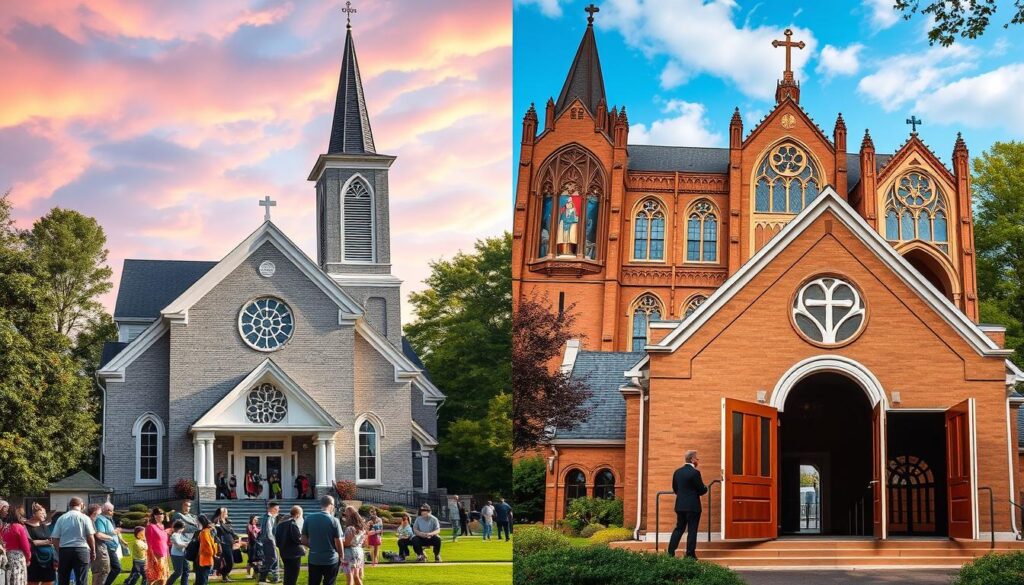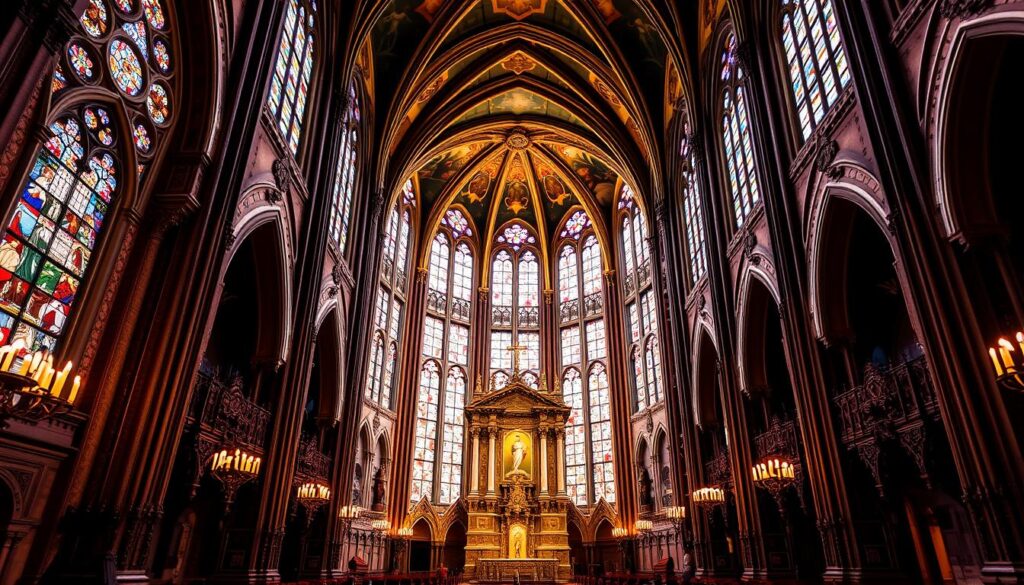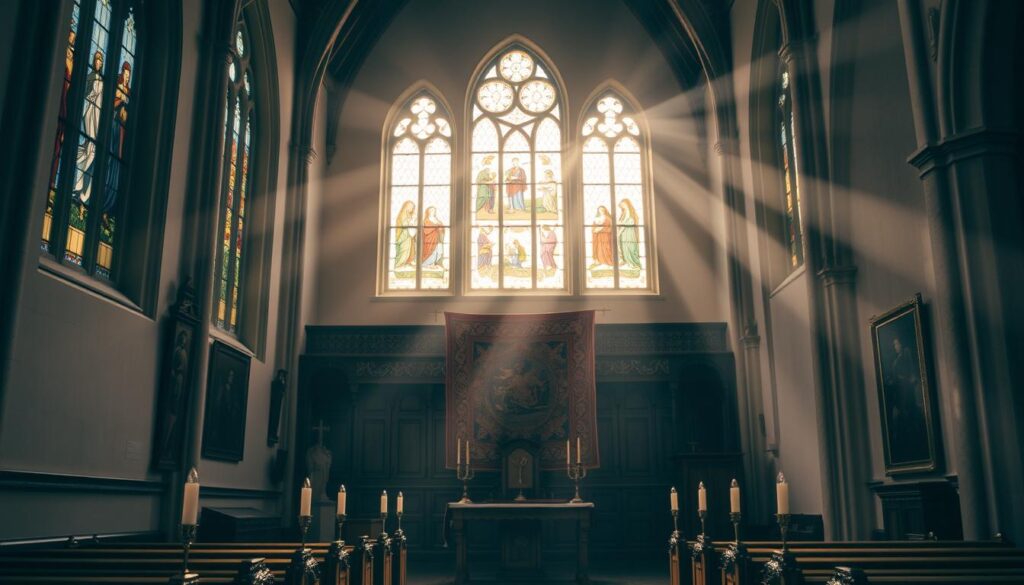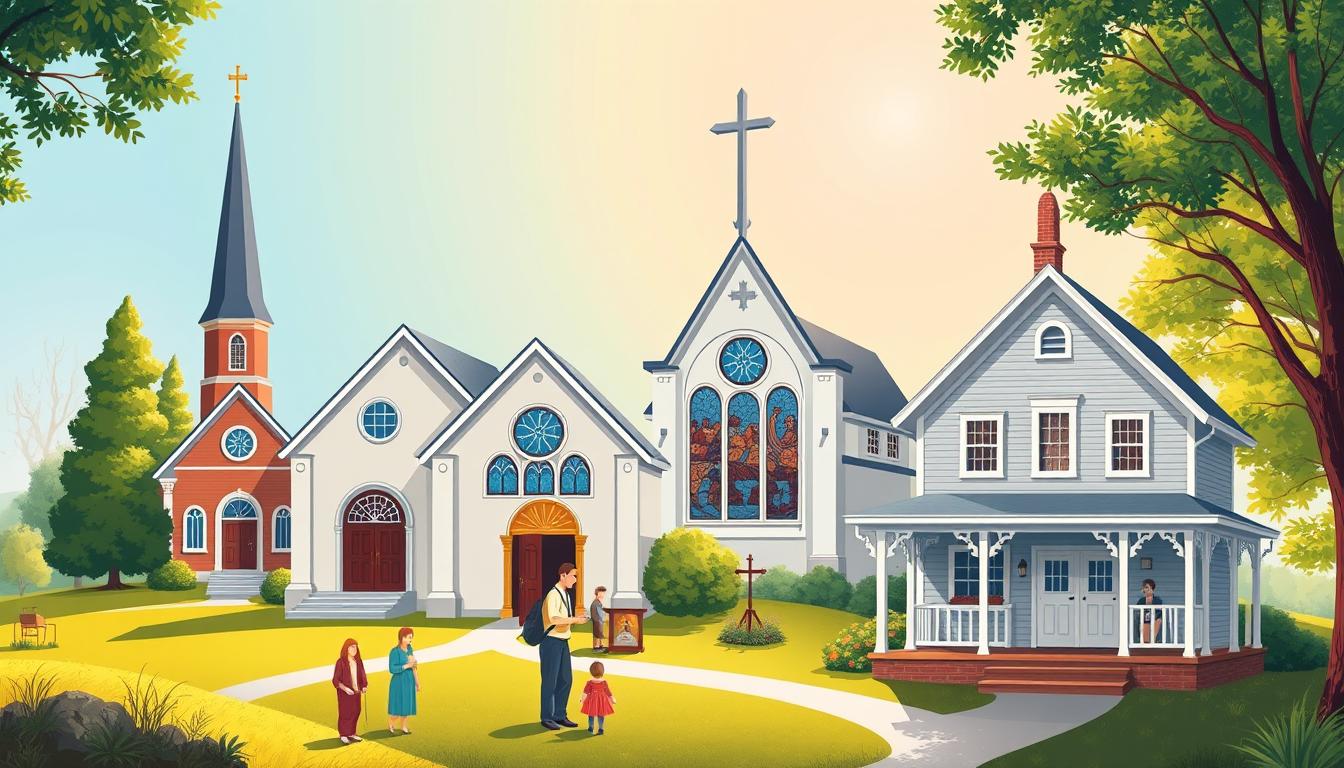Christians often have different views on the Bible and church practices. They disagree on who should lead the church and how decisions are made. Denominations like Presbyterian, Methodist, Anglican, and Baptist differ in their beliefs and practices. This article will look at the main differences between these denominations, focusing on their beliefs, practices, and church structure.
Key Takeaways
- Methodists and Presbyterians have different beliefs on the Bible, salvation, and church leadership.
- They also disagree on baptism and communion.
- Presbyterian churches have a complex leadership structure. Methodist churches have a more straightforward hierarchy.
- Methodists believe you can lose your salvation. Presbyterians believe it’s predestined and can’t be lost.
- Notable pastors from each denomination include John and Charles Wesley, John Knox, and Charles Finney.
Introduction to Christian Denominations
Christianity is the biggest religion, with many denominations. Each has its own views, practices, and traditions. The Catholic Church is huge, known for its rituals and sacraments. The Protestant tradition has led to many churches, like Presbyterian, Methodist, Anglican, and Baptist, each with its own beliefs and practices.
Denominations differ because of different views on the Bible, church rules, and religious practices. For example, the Episcopal and Anglican Churches in America have different branches. Presbyterianism splits between the PC-USA and PCA, and Lutheranism has the ELCA and LCMS in the U.S.
The Baptist Church focuses on adult baptism and local church control. The Methodist Church in the U.S. is splitting, with the Global Methodist Church being more conservative. Pentecostalism, the biggest Protestant group, is growing fast in Asia and Africa.
These differences show the rich variety in Christianity. Each group tries to follow the Bible in its own way, based on its beliefs and traditions.

| Denomination | Key Characteristics |
|---|---|
| Catholic Church | Largest Christian denomination, follows liturgical tradition with sacraments |
| Southern Baptist Convention | One of the largest Baptist groups in the U.S., emphasizes conservative theology and personal conversion |
| Episcopal Church | One of the two major branches of the Anglican tradition in America |
| Presbyterian Church in America (PCA) | More conservative branch of Presbyterianism in the U.S. |
| Evangelical Lutheran Church in America (ELCA) | Liberal branch of Lutheranism in the U.S. |
| Missouri Synod Lutheran Church (LCMS) | Conservative branch of Lutheranism in the U.S. |
| Global Methodist Church | More conservative group that split from the Methodist Church in the U.S. |
“The unity of the church is not a unitary uniformity, but a unity in diversity.” – Avery Dulles, American Catholic theologian
The Eastern Orthodox Church
The Eastern Orthodox Church, also known as Orthodox Christianity, is one of the oldest branches of Christianity. It started in the Byzantine Empire, where it was key to the culture and faith. Today, it makes up 11.1% of World Christianity, found all over the world, not just in Eastern Europe and the Middle East.
History and Origins
The Eastern Orthodox Church comes from the apostles and the early Christian Church. It broke away from the Roman Catholic Church in 1054 AD, during the Great Schism. This split was over issues like the papacy, icons in worship, and the Filioque clause in the Nicene Creed.
Worship and Practices
The Eastern Orthodox Church is famous for its beautiful liturgical worship. It uses icons, incense, chanting, and the Eucharist. These traditions connect the faithful to the divine, rooted in Byzantine heritage.
The church also honors saints and celebrates holy days and festivals. These are key to its liturgical calendar.
Church Governance and Leadership
The Eastern Orthodox Church is led by bishops, seen as the apostles’ successors. Bishops appoint priests to care for local churches and guide the faithful. The church is organized in a way that values unity and diversity, with each national and regional patriarchate having its own traditions.

“The Eastern Orthodox Church is a living witness to the richness and diversity of the Christian tradition, with its deep roots in the Byzantine Empire and its enduring commitment to liturgical worship, iconography, and the apostolic succession.”
The Roman Catholic Church
The Roman Catholic Church has a long and rich history. It goes back to the early ecumenical councils that shaped Christian beliefs. After the East-West Schism in 1054, the Western church grew and changed. Important figures like Augustine, Aquinas, and Francis of Assisi helped shape Catholic thought and practices over the years.
Sacraments and Beliefs
The Roman Catholic Church values liturgical worship and the seven sacraments a lot. It has a special view of the Eucharist called transubstantiation. The Church sees these sacraments as ways to receive divine grace, with the Eucharist being the most important act of worship.
Papal Authority and Structure
The Catholic Church has a strict hierarchy, with the pope at the top. The pope, as Saint Peter’s successor, holds the highest authority and control over the church. This structure and the pope’s role have been key parts of the Catholic tradition for centuries.
| Denomination | Percentage of World Christianity | Approximate Number of Members |
|---|---|---|
| Roman Catholic Church | 48.6% | Over 1.3 billion |
| Protestantism | 39.8% | Varies by denomination |
| Eastern Orthodox | 11.1% | Approximately 260 million |
| Other Christian Denominations | 0.5% | Varies |

“The Roman Catholic Church is the largest denomination, representing nearly half of all Christians worldwide.”
The Protestant Tradition
The Protestant Tradition started in the 16th century. It was led by Martin Luther, John Calvin, and Ulrich Zwingli. They wanted to fix what they saw as wrong in the medieval Catholic Church.
The Reformation Movement
The Reformation had five main points, known as the five solas. These were: Scripture alone, faith alone, grace alone, Christ alone, and God alone. They focused on the Bible, faith, and God’s power.
The Five Solas
- Sola Scriptura (Scripture alone): The Bible is the only source of God’s word and the main guide for faith and actions.
- Sola Fide (faith alone): You get saved by believing in Christ, not by doing good deeds or anything else.
- Sola Gratia (grace alone): Salvation is a free gift from God, not something you can earn.
- Solus Christus (Christ alone): Jesus Christ is the only one who can connect us to God, and His death is the only way to be saved.
- Soli Deo Gloria (glory of God alone): All praise and honor should go to God, not to people or groups.
These five solas are the base of Protestant beliefs. They still guide many Protestant churches today.

“The Reformation was a movement of the Holy Spirit to restore the Gospel and to return the church to its biblical foundations.” – Martin Luther
The Anglican Communion
The Anglican Communion started when the Church of England broke away from the Roman Catholic Church in 1534. Anglicans cherish old traditions and liturgical worship, led by the Book of Common Prayer. This global family of churches shares a common heritage. They recognize the Archbishop of Canterbury as a symbol of unity, yet each province governs itself.
Origins and Separation from Rome
The Anglican Communion’s roots are in England, dating back centuries after Christ. The Church of England became independent from Rome through the English Reformation. It introduced reforms like a vernacular Bible. In the 18th and 19th centuries, Anglicanism saw revivals, blending evangelical and catholic aspects of faith.
Liturgy and Book of Common Prayer
The Anglican Church combines Protestant and Catholic traditions, influenced by the Reformation and the Church Fathers. The Book of Common Prayer has been key in Anglican liturgical worship since the 16th century. It provides a unified structure for worship across the Anglican Communion.
| Denomination | Membership |
|---|---|
| United Methodist Church | 7.6 million |
| African Methodist Episcopal Church (AMEC) | 2.5 million |
| African Methodist Episcopal Zion Church (ECO) | 301,000 |
| Christian Methodist Episcopal Church (CMEC) | 290,000 |
| Anglican Communion | Global network of churches |

“Anglicanism can be described as either Protestant, as a middle way between Catholicism and Protestantism, or a middle ground between Presbyterianism and Lutheranism based on different perspectives.”
Presbyterian vs Methodist vs Anglican vs Baptist
The Presbyterian, Methodist, Anglican, and Baptist denominations have different ways of organizing their churches. Ecclesiology is the study of the church’s nature, structure, and authority. Each tradition has its own views on clergy roles, congregation organization, and church governance.
Ecclesiastical Polity and Governance
The Presbyterian church has a presbyterian structure. Elected elders, or presbyters, lead at local, regional, and national levels. The Methodist church, like the Anglican Communion, has an episcopal structure. Bishops lead regional districts and guide the church. Baptists follow a congregational model, where each local church makes its own decisions.
| Denomination | Ecclesial Polity | Church Governance |
|---|---|---|
| Presbyterian | Presbyterian | Elders (presbyters) provide leadership |
| Methodist | Episcopal | Bishops oversee regional districts |
| Anglican | Episcopal | Bishops oversee regional dioceses |
| Baptist | Congregational | Local church autonomy in decision-making |
Different views on church leadership and authority set these denominations apart. These choices reflect deep theological differences in ecclesiology, the study of the church’s nature and mission.
“The church’s unity is rooted in the very nature of God as Trinity—one God in three persons, Father, Son, and Holy Spirit. As the church, we are called to reflect that unity in our diversity.”
Lutheranism
Lutheranism started with Martin Luther, a German Reformer. He challenged the Catholic Church’s teachings. Lutherans believe in sola scriptura, or Scripture alone, and the priesthood of all believers. They focus on the difference between the law and the gospel and the importance of justification by faith alone.
Lutherans believe in the authority of the Bible and salvation by grace through faith. They don’t agree with the Catholic Church’s views on purgatory, indulgences, or the need for good works to be saved. They think faith alone justifies people, and God’s grace is freely given to believers.
The Lutheran Church values worship and preaching a lot. They have weekly services with Scripture reading, hymns, and the Eucharist. The Book of Concord is key to Lutheran beliefs and practices.
Over time, Lutheranism has grown with different branches and denominations. The Evangelical Lutheran Church in America (ELCA) is known for its progressive views. The Lutheran Church-Missouri Synod (LCMS) is more conservative.
“The true treasure of the church is the most holy gospel of the glory and the grace of God.” – Martin Luther
Lutheranism is a big part of the Protestant Reformation. It focuses on sola scriptura, the priesthood of all believers, and justification by faith alone.
Reasons for Denominational Differences
Christian churches differ mainly because of how they govern themselves, what they believe, and how they practice their faith. Each church has its own way of understanding the Bible, what worship should look like, and who should lead. These differences shape the unique identity of each denomination within Christianity.
Ecclesiology
Ecclesiology, or church governance, plays a big role in why churches are different. Churches like Presbyterians, Methodists, and Baptists have different views on leadership and decision-making. These views affect how the church is organized and run.
Orthodoxy
Beliefs and doctrines, or orthodoxy, also cause divisions. Protestant churches like Assembly of God and Lutheran focus on the Bible alone. But Anglican/Episcopal and Roman Catholic churches also look to church fathers and tradition. These differences in beliefs make each denomination unique.
Orthopraxy
Practices and liturgy, or orthopraxy, also lead to different churches. Churches vary in their worship styles, sacraments, and traditions. These practices help define each denomination’s identity.
In short, differences in church governance, beliefs, and practices cause denominational divisions. These differences create a variety of denominations, each with its own traditions and beliefs.
| Denomination | Basis of Beliefs | Creedal Affirmations | View on Bible Inerrancy |
|---|---|---|---|
| Protestant (Assembly of God, Baptist, Lutheran, Methodist, Presbyterian) | Bible only | Varies by denomination | Varies by denomination |
| Anglican/Episcopal | Scripture, Church Fathers | Apostles’ Creed, Nicene Creed | Inspired according to Book of Common Prayer |
| Roman Catholic | Scripture, Church Fathers | Apostles’ Creed, Nicene Creed, Other Creeds | Not specified |
| Presbyterian | Bible, Confession of Faith | Apostles’ Creed, Nicene Creed, Westminster Confession | Varying views on inerrancy |
| Baptist | Bible | Apostles’ Creed, Nicene Creed | Inspired and inerrant |
| Methodist | Bible | Apostles’ Creed, Nicene Creed | Inspired and inerrant |
| Lutheran | Bible, Various Creeds and Confessions | Apostles’ Creed, Nicene Creed, Athanasian Creed, Augsburg Confession, Formula of Concord | Inspired and inerrant (Missouri Synod and ELCA) |
“The diversity of Christian denominations reflects the richness of theological perspectives and the continued search for truth within the broader Christian tradition.”
The Anglican Tradition
The Anglican Communion includes the Church of England and its worldwide affiliates. It is known for its liturgical worship, guided by the Book of Common Prayer. Anglicanism stands between Lutheranism and Calvinism, known as via media. It is one of the largest Christian branches, with about 110 million followers globally as of 2001. The Anglican Communion is the third-largest Christian communion, after the Catholic and Eastern Orthodox Churches.
Anglicans believe in two sacraments: baptism and the Eucharist. They have different views on Christ’s presence in the Lord’s Supper, but reject transubstantiation. Their faith is based on the Bible, traditions, apostolic succession, and writings of the Church Fathers. They also follow the Thirty-nine Articles of Religion and The Books of Homilies.
The Book of Common Prayer is a key part of Anglicanism. It connects the Anglican Communion as a liturgical tradition. Anglicans, also known as Episcopalians in some countries, form the Communion. It consists of national or regional ecclesiastical provinces.
The Anglican Communion is in full communion with the See of Canterbury. The Archbishop of Canterbury leads the Communion. He organizes the Lambeth Conference, chairs the meeting of primates, and presides over the Anglican Consultative Council. The Communion also includes churches outside of it, like the Continuing Anglican movement and Anglican realignment.
“The Anglican Communion is the world’s largest Protestant communion.”
The Presbyterian Church
The Presbyterian Church has deep roots in the Scottish Reformation and John Knox’s teachings. It is known for its hierarchical church government. Elected Elders, both lay and clergy, lead the local congregation and regional presbyteries.
The church follows Reformed theology, as seen in the Westminster Confession of Faith. This belief system highlights God’s sovereignty, the Bible’s authority, and Calvinism.
- The Presbyterian Church is among the oldest Protestant denominations, with about 75 million followers worldwide.
- In the U.S., the Presbyterian Church (USA) is a major denomination, with around 1.4 million members.
The church values the community of believers and the local church’s authority. This structure empowers the congregation in church governance and decision-making.
Theology and Confessions
Presbyterians adhere to Reformed theology, influenced by John Calvin and other Reformation thinkers. The Westminster Confession of Faith outlines their beliefs, including God’s sovereignty and the Bible’s authority.
“The Presbyterian Church’s theology is deeply influenced by the Calvinist tradition, emphasizing the sovereignty of God and the importance of biblical authority.”
The church’s commitment to Reformed theology and the Westminster Confession has shaped its identity. It has influenced its views on ecclesiology, sacraments, and the role of church elders.
| Characteristic | Presbyterian Church | Methodist Church | Anglican Church | Baptist Church |
|---|---|---|---|---|
| Ecclesiology | Presbyterianism, with elected elders | Episcopal, with bishops | Episcopal, with bishops | Congregationalism, with autonomous local churches |
| Theology | Reformed theology, Calvinism | Arminian theology | Via media, with elements of Catholic and Protestant theology | Baptistic theology, emphasizing believer’s baptism |
| Sacraments | Two sacraments: Baptism and Communion | Two sacraments: Baptism and Communion | Seven sacraments, similar to Catholic Church | Two ordinances: Believer’s Baptism and Communion |
The Presbyterian Church’s focus on Reformed theology and the Westminster Confession has defined its identity. It has shaped its views on church structure, sacraments, and the role of church elders.
The Baptist Church
The Baptist Church values local church autonomy, where each church makes its own decisions. They reject infant baptism, instead believing in believer’s baptism by immersion as a sign of faith.
Congregational Autonomy
Baptists believe in the local church’s freedom and the direct connection between individuals and God. Each church chooses its leaders and decides on its beliefs and practices. This shows the Baptist belief in the priesthood of all believers, where everyone can talk directly to God.
Believer’s Baptism
Baptists believe in baptism for those who have chosen to follow Christ, not for infants. They see baptism by immersion as a symbol of dying to sin and being reborn in Christ. This makes Baptists different from other Christian groups that baptize infants or use other methods.
| Denomination | Sacraments | Baptism | Social Issues |
|---|---|---|---|
| Catholic | 7 sacraments | Sprinkling | Oppose abortion, gay marriage, divorce, capital punishment, genetic research |
| Methodist | 2 sacraments (Baptism, Lord’s Supper) | Sprinkling | Varying positions on social issues |
| Baptist | 2 sacraments (Baptism, Lord’s Supper) | Immersion | Oppose abortion, gay marriage, divorce, genetic research |
“The Baptist Church is distinctive in its emphasis on the autonomy of the local congregation and the importance of believer’s baptism through immersion.”
The Baptist Church’s focus on local church freedom and believer’s baptism shows its roots in the Protestant Reformation. This approach shapes the identity and mission of Baptist churches around the world.
The Methodist Church
The Methodist Church is a Protestant Christian group with a long history. It has its own beliefs and ways of organizing. It follows the Wesleyan-Arminian theology, which talks about free will and the chance of losing salvation. This is different from the Calvinist views found in some other Christian groups.
The Methodist Church has an episcopal structure, like the Anglican Communion. Bishops lead and oversee the church. This helps the church make decisions and stay united.
Methodists value the sacraments of baptism and the Eucharist. They believe Christ is truly present in the Communion bread and wine. Their services are often more contemporary than some other Protestant churches. This makes the church feel welcoming and relevant to today’s world.
The Methodist Church is big, with churches in over 165 countries. It remains a lively and important part of Christianity. It offers a mix of beliefs, leadership, and worship styles.
The Pentecostal Movement
The Pentecostal movement is known for believing in ongoing spiritual gifts like speaking in tongues and healing. It often follows a congregational form of leadership, but the senior pastor can have a lot of power. Pentecostals see the baptism of the Holy Spirit as a special experience that gives believers the power to use these gifts.
This movement started in the early 20th century and has grown worldwide. Pentecostals believe in the Holy Spirit’s ongoing work in believers’ lives. They think spiritual gifts like speaking in tongues and healing show the Holy Spirit’s presence and power.
Pentecostalism is known for its lively worship and emotional expressions. But it’s a diverse movement with many beliefs and practices. Some churches are more formal, while others are more spontaneous. At its core, Pentecostalism is about the Holy Spirit’s power and the supernatural in believers’ lives.
Pentecostals focus on the “baptism of the Holy Spirit,” a special experience beyond conversion. They believe this baptism gives believers the power to use gifts like speaking in tongues and healing. This emphasis on the supernatural has both attracted and caused controversy in the Christian world.
Despite controversy, the Pentecostal movement has greatly influenced global Christianity. It has grown fast, especially in the Global South, becoming a major force in Christianity worldwide. Its focus on the Holy Spirit and spiritual gifts continues to draw believers, shaping the movement for today’s world.
Conclusion
The variety of Christian denominations shows the church’s complex history. It also highlights different views on Scripture, worship, and church leadership. Despite these differences, all denominations share a common belief in Jesus Christ and the Christian tradition.
Understanding these differences helps us see the richness of the global church. For example, the Anglican Church in North America is growing, while the Southern Baptist Convention is declining.
The Protestant Reformation led to many different churches. Methodists and Presbyterians, for instance, have different beliefs and ways of organizing their churches. Yet, they all agree on the main teachings of Christianity, showing the church’s ongoing growth.
The variety of Christian denominations shows the church’s vibrant and changing nature. It encourages believers to have open and respectful conversations about their faith.
FAQ
What are the key differences between the Presbyterian, Methodist, Anglican, and Baptist denominations?
These denominations differ in church governance, beliefs, and practices. Presbyterians have a system with elected elders. Methodists have bishops. Anglicans value historic traditions and liturgy. Baptists have a congregational model with local decision-making.
How do the Eastern Orthodox and Roman Catholic churches differ from Protestant denominations?
Eastern Orthodox and Roman Catholic churches focus on liturgical worship and sacraments. They have a hierarchical structure. Protestant denominations emerged from the Reformation. They believe in Scripture alone and faith alone.
What are the core beliefs and practices of Lutheranism?
Lutheranism comes from Martin Luther’s teachings. It believes in Scripture alone. Lutherans focus on faith alone for justification. They also believe in the priesthood of all believers.
How do the Presbyterian and Baptist churches differ in their views on church governance and baptism?
Presbyterians have a system with elected elders. Baptists have local church autonomy. Baptists reject infant baptism and practice believer’s baptism. Presbyterians baptize infants.
What are the distinctive features of the Anglican Communion?
The Anglican Communion values liturgical worship and a middle path between Lutheranism and Calvinism. They recognize two sacraments and have diverse views on the Lord’s Supper. They reject the Catholic doctrine of transubstantiation.
How does the Methodist Church differ from other Protestant denominations?
The Methodist Church has an episcopal structure with bishops. They follow Wesleyan-Arminian theology, emphasizing free will. Methodists also have contemporary worship styles.
What are the key characteristics of the Pentecostal movement?
The Pentecostal movement believes in spiritual gifts like speaking in tongues and healing. They have a congregational form of governance. Pentecostals believe in a distinct baptism of the Holy Spirit that empowers believers.

